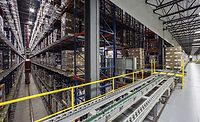Warehouse Execution Systems produce consistent, accurate fulfillment
Warehouse workers increasingly implement WES for day-to-day operations

As the beverage industry continues to see an influx of SKUs, manufacturers and distributors must stay up-to-date with the latest software in order to keep up with demand. As warehouses look to enhance their operations, the implementation of warehouse execution systems (WES) seem to be the golden ticket to getting the job done.
A white paper titled “Overcoming the Order Fulfillment Burden with Warehouse Execution Systems,” written by Dave Williams, director of software and solution delivery for Westfalia Technologies Inc., York, Pa., highlights the common challenges warehouse operators face that create inefficiencies throughout the fulfillment process.
- Limited space: warehouse might have limited space for storing and staging orders.
- Unreliable transportation: a shortage of drivers is causing unreliability within the transportation industry. Without a streamlined inventory management process, this could be a large problem.
- Lack of communication: often a lack of communication between sales, manufacturing, warehousing, distribution, and even the customer can be found within warehouse operations. This leads to additional changes to customer orders taking place late in the process.
However, wholesalers that are utilizing WES can streamline the process, allowing for easier execution, reduced costs and increased throughput, experts note.
“Utilizing a warehouse execution system can relieve the manual standard operating procedures that are needed to coordinate work for the day or shift,” says Suzanne McGough, product manager at Honeywell Intelligrated, Mason, Ohio. “By having a more intelligent system capable of making decisions throughout the day, operations can see an increase in throughput and visibility, without the need to add additional labor.”
Implementing intelligent systems
Previously, both warehouse management systems (WMS) and warehouse control software (WCS) were used in warehouse operations. However, experts note that as the challenges of SKU proliferation arise, WES’ are providing the functionalities of WMS and WCS, but in a single system.
WES offers the inventory management, storage optimization and traceability features of a WMS, as well as the automation components of WCS, which provide a real-time view of material handling equipment, labor status and other key performance indicators (KPIs) crucial to efficient warehouse operations, according to Westfalia’s Williams’ white paper.
On a similar note, Honeywell Intelligrated’s McGough highlights the benefits of implementing WES. “Traditionally, a WMS excels at managing buildings with low levels of automation,” she says. “A WMS can send updates to the ERP [enterprise resource planning] and instructs users out on the floor what to pick, but these systems do not integrate with automation out of the box.
“If you are looking to minimize labor and increase automation, a WES system would be a better fit as it can orchestrate the right work at the right time while looking at downstream capacities within the material handling automation equipment,” she continues. “Instead of treating the system as a black box and ‘dumping’ work blindly into the day’s shift, a WES will continuously release work that it knows the system can handle, while also keeping order cut-off times in mind.”
Experts tout the numerous advantages WES systems have compared with traditional WMS and WCS systems. In the white paper, Westfalia’s Williams highlights three major benefits:
- Built-in order planning: this allows shipment planners and dock coordinators to determine inventory and transportation availability and compare that with order demand.
- Receiving and tracking: it provides the functionality to receive and track product, while optimally marrying inventory to customer orders through its order fulfillment processing capabilities.
- Labor breakdown: it breaks the orders into logical units of work and appropriately distributes the tasks.
Williams also acknowledges other important advantages of WES as it allows users to maximize the benefits of automated systems while increasing inventory accuracy and reducing labor costs, the white paper states.
“Second, the solution is also scalable and customizable — users can turn on and off the functionality needed to meet their requirements and set up specific business rules,” it continues. “It can even interface with other applications, such as corporate ERP systems and programmable logic controllers. Third, a single system creates consistency across an organization’s facilities and typically requires a shorter learning curve for operations and IT personnel.”
Because of the benefits that WES solutions offer to warehouse operations, experts recommend that managers take into consideration a few factors. Implementing any new software within a new or existing operation is never an easy task, Honeywell Intelligrated’s McGough says.
“It’s important to plan cutover strategies and new processes before determining when it is best to implement new software,” she explains. “Factors like the need for expansion, implementation of new automation and the need for increased throughput are good reasons to consider a [WES] system, as it bridges the gap between high-level WMS capabilities and low-level WCS capabilities.
“It’s [also] important to understand what the issues are with your current processes and what benefits you are looking to achieve to pinpoint which software makes sense,” she adds.
McGough also explains that WES’ are typically used for larger, more complex systems with 100 or more users. However, a warehouse execution system should be modular so that it can be tailored to different operational needs and still make sense for smaller sized operations, she says.
In April, Honeywell Intelligrated unveiled its Momentum Warehouse Execution System, a new software platform that powers connected distribution centers to support eCommerce growth, the company said in a statement. Momentum brings together automated equipment, workflows, orders and labor in a unified platform to provide distribution center operators real-time visibility and help make operations more efficient, it said.
“Many of today’s warehouse execution systems are a patchwork of custom software and control solutions, so we’ve taken a vastly different, clean-sheet approach that prioritizes stability and simplicity to enable a connected distribution center,” said Pieter Krynauw, president of Honeywell Intelligrated, in a statement.
Likewise, Westfalia offers its Savanna.NET, a WES that combines WMS and WCS operations. The program simplifies and controls the entire warehousing process, while reducing the complexity of using several different “function-specific” applications, the company said in a statement. As a result, users can more efficiently utilize warehouse space and equipment, increase order accuracy, improve customer service, reduce the risk of lost or damaged product, and raise throughout and productivity, it continued. BI
Looking for a reprint of this article?
From high-res PDFs to custom plaques, order your copy today!







